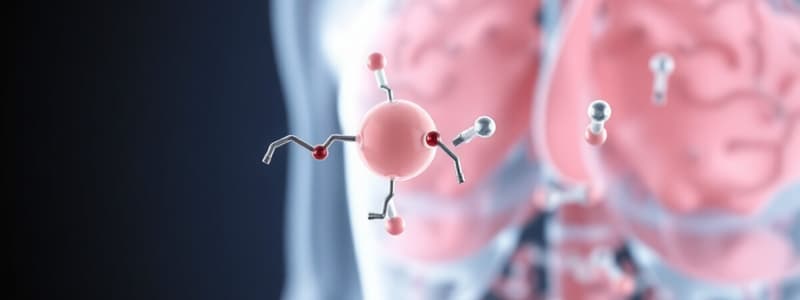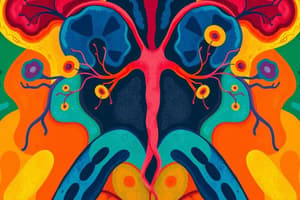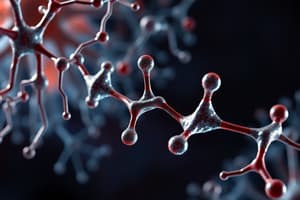Podcast
Questions and Answers
Which of the following best describes the mechanism of action for steroid hormones?
Which of the following best describes the mechanism of action for steroid hormones?
- They act through a second messenger system on the cell surface.
- They are produced by enzymes in the smooth endoplasmic reticulum and mitochondria and require carrier proteins for blood transport. (correct)
- They are released directly into the bloodstream and travel freely to target cells.
- They are synthesized in the rough endoplasmic reticulum and stored in vesicles.
Which of the following is NOT a characteristic of peptide hormones?
Which of the following is NOT a characteristic of peptide hormones?
- They are packaged in the Golgi complex.
- They are stored in secretory vesicles before release.
- They are synthesized by the cooperative action of enzymes located in smooth endoplasmic reticulum and mitochondria (correct)
- They are synthesized in the rough endoplasmic reticulum.
What is the primary difference between endocrine and paracrine signaling?
What is the primary difference between endocrine and paracrine signaling?
- Endocrine signaling involves hormones binding to cell surface receptors, while paracrine signaling involves hormones entering the cell.
- Endocrine signaling affects many different cell types, whereas paracrine signaling affects only a single cell type
- Paracrine signaling involves rapid, short-term responses, while endocrine signaling results in long-term changes.
- Endocrine hormones travel through the bloodstream to distant sites, while paracrine hormones act on neighboring cells via diffusion. (correct)
What describes an autocrine effect?
What describes an autocrine effect?
Based on the organization presented, what is a key shared characteristic between the thyroid and parathyroid glands?
Based on the organization presented, what is a key shared characteristic between the thyroid and parathyroid glands?
According to the content, what do amino acid analogues and catecholamines have in common?
According to the content, what do amino acid analogues and catecholamines have in common?
Based on the information provided, the adrenal gland is similar to the thyroid and parathyroid in which aspect?
Based on the information provided, the adrenal gland is similar to the thyroid and parathyroid in which aspect?
In the adrenal gland, where do the thin-walled cortical capillaries, carrying hormone-rich but oxygen-poor blood, initially merge with oxygen-rich blood from medullary arterioles?
In the adrenal gland, where do the thin-walled cortical capillaries, carrying hormone-rich but oxygen-poor blood, initially merge with oxygen-rich blood from medullary arterioles?
Which of the following is NOT a characteristic of the cells within the zona glomerulosa?
Which of the following is NOT a characteristic of the cells within the zona glomerulosa?
Which of the following best describes the mechanism of action for protein hormones?
Which of the following best describes the mechanism of action for protein hormones?
What is the primary function of aldosterone, produced by the zona glomerulosa?
What is the primary function of aldosterone, produced by the zona glomerulosa?
How do steroid hormones typically exert their physiological effects?
How do steroid hormones typically exert their physiological effects?
Which of the following describes the order of zones in the adrenal gland cortex, from outermost to innermost?
Which of the following describes the order of zones in the adrenal gland cortex, from outermost to innermost?
Which characteristic is associated with endocrine glands?
Which characteristic is associated with endocrine glands?
How do the cells of the zona glomerulosa primarily obtain cholesterol, a precursor for steroid hormone synthesis?
How do the cells of the zona glomerulosa primarily obtain cholesterol, a precursor for steroid hormone synthesis?
The pineal gland develops as a dorsal extension from which part of the brain?
The pineal gland develops as a dorsal extension from which part of the brain?
What happens to the lumen of the pineal gland as it matures?
What happens to the lumen of the pineal gland as it matures?
What is the connective tissue covering that surrounds the pineal gland?
What is the connective tissue covering that surrounds the pineal gland?
How is the parenchyma of the pineal gland organized?
How is the parenchyma of the pineal gland organized?
What is the major cell type found within the pineal gland?
What is the major cell type found within the pineal gland?
Which of the following is a distinct characteristic of pinealocytes?
Which of the following is a distinct characteristic of pinealocytes?
Which ratio accurately represents the production of T4 to T3 by the thyroid gland?
Which ratio accurately represents the production of T4 to T3 by the thyroid gland?
Where are T3 and T4 primarily transported within the body?
Where are T3 and T4 primarily transported within the body?
What is the key function of T3 and T4 hormones regarding metabolic processes?
What is the key function of T3 and T4 hormones regarding metabolic processes?
Which hormone directly controls all stages of T3 and T4 synthesis?
Which hormone directly controls all stages of T3 and T4 synthesis?
How is the release of TRH regulated?
How is the release of TRH regulated?
In which locations is T3 generated from T4?
In which locations is T3 generated from T4?
What is a distinctive characteristic of parafollicular cells in terms of staining?
What is a distinctive characteristic of parafollicular cells in terms of staining?
Where can parafollicular cells be found within the thyroid gland?
Where can parafollicular cells be found within the thyroid gland?
What is the primary product secreted by parafollicular cells?
What is the primary product secreted by parafollicular cells?
Which of the following best describes the characteristic spatial arrangement of secretory granules in parafollicular cells?
Which of the following best describes the characteristic spatial arrangement of secretory granules in parafollicular cells?
Based on the provided information, what is the primary role of parathyroid hormone (PTH) when blood calcium levels are low?
Based on the provided information, what is the primary role of parathyroid hormone (PTH) when blood calcium levels are low?
Which of the following best describes the appearance and characteristics of oxyphil cells in the parathyroid gland?
Which of the following best describes the appearance and characteristics of oxyphil cells in the parathyroid gland?
What is the functional relationship between calcitonin and parathyroid hormone (PTH) as described in the given content?
What is the functional relationship between calcitonin and parathyroid hormone (PTH) as described in the given content?
How does PTH indirectly stimulate osteoclast activity?
How does PTH indirectly stimulate osteoclast activity?
At what stage of life do oxyphil cells typically appear in the parathyroid gland, according to the text?
At what stage of life do oxyphil cells typically appear in the parathyroid gland, according to the text?
What cellular components are characteristic of oxyphil cells, based on the description in the given information?
What cellular components are characteristic of oxyphil cells, based on the description in the given information?
Which cellular feature is identified within the chief cells of the parathyroid gland by the text?
Which cellular feature is identified within the chief cells of the parathyroid gland by the text?
What is the primary source of the secretory granules mentioned in the parathyroid gland cells?
What is the primary source of the secretory granules mentioned in the parathyroid gland cells?
Besides bone, what other organ systems are targeted by Parathyroid Hormone (PTH) to help elevate blood calcium levels?
Besides bone, what other organ systems are targeted by Parathyroid Hormone (PTH) to help elevate blood calcium levels?
According to the provided content, what is a characteristic of the fenestrated capillaries in the parathyroid gland?
According to the provided content, what is a characteristic of the fenestrated capillaries in the parathyroid gland?
Flashcards
Endocrine System
Endocrine System
A group of organs that produce and release hormones into the bloodstream, regulating various bodily functions.
Hormones
Hormones
Chemical messengers produced by endocrine glands that influence the activity of cells and organs.
Paracrine Hormones
Paracrine Hormones
Hormones that act on nearby cells in a local manner.
Autocrine Hormones
Autocrine Hormones
Signup and view all the flashcards
Peptide Hormones
Peptide Hormones
Signup and view all the flashcards
Steroid Hormones
Steroid Hormones
Signup and view all the flashcards
Amino Acid Analogues & Derivatives
Amino Acid Analogues & Derivatives
Signup and view all the flashcards
Pineal gland Location
Pineal gland Location
Signup and view all the flashcards
Pineal Lumen
Pineal Lumen
Signup and view all the flashcards
Pineal Gland Covering
Pineal Gland Covering
Signup and view all the flashcards
Pineal Parenchyma Structure
Pineal Parenchyma Structure
Signup and view all the flashcards
Pinealocyte Description
Pinealocyte Description
Signup and view all the flashcards
Pineal Gland Function
Pineal Gland Function
Signup and view all the flashcards
Pineal Gland Hormone
Pineal Gland Hormone
Signup and view all the flashcards
How Steroid Hormones Work
How Steroid Hormones Work
Signup and view all the flashcards
How Protein Hormones Work
How Protein Hormones Work
Signup and view all the flashcards
How are T3 and T4 Transported?
How are T3 and T4 Transported?
Signup and view all the flashcards
What Happens to MIT and DIT?
What Happens to MIT and DIT?
Signup and view all the flashcards
What Regulates T3 and T4 Production?
What Regulates T3 and T4 Production?
Signup and view all the flashcards
How is TRH Release Regulated?
How is TRH Release Regulated?
Signup and view all the flashcards
What is the Ratio of T4 and T3 Production?
What is the Ratio of T4 and T3 Production?
Signup and view all the flashcards
Which is More Active: T3 or T4?
Which is More Active: T3 or T4?
Signup and view all the flashcards
Where is T4 Converted to T3?
Where is T4 Converted to T3?
Signup and view all the flashcards
What is the Function of T3 and T4?
What is the Function of T3 and T4?
Signup and view all the flashcards
How do T3 and T4 Affect Body Temperature?
How do T3 and T4 Affect Body Temperature?
Signup and view all the flashcards
How do T3 and T4 Affect Growth?
How do T3 and T4 Affect Growth?
Signup and view all the flashcards
Zona Glomerulosa
Zona Glomerulosa
Signup and view all the flashcards
Aldosterone
Aldosterone
Signup and view all the flashcards
Angiotensin II
Angiotensin II
Signup and view all the flashcards
Venous Return in the Adrenal Gland
Venous Return in the Adrenal Gland
Signup and view all the flashcards
Adrenal Cortex Zones
Adrenal Cortex Zones
Signup and view all the flashcards
Chief cells
Chief cells
Signup and view all the flashcards
Oxyphil cells
Oxyphil cells
Signup and view all the flashcards
Parathyroid hormone (PTH)
Parathyroid hormone (PTH)
Signup and view all the flashcards
Bone resorption
Bone resorption
Signup and view all the flashcards
Osteoclasts
Osteoclasts
Signup and view all the flashcards
Osteoblasts
Osteoblasts
Signup and view all the flashcards
Kidney tubular reabsorption
Kidney tubular reabsorption
Signup and view all the flashcards
Intestinal calcium absorption
Intestinal calcium absorption
Signup and view all the flashcards
Calcitonin
Calcitonin
Signup and view all the flashcards
PTH and calcitonin interaction
PTH and calcitonin interaction
Signup and view all the flashcards
Study Notes
Microanatomy of Endocrine Glands II
-
Pineal Gland (Epiphysis Cerebri):
- Located as a dorsal extension from the posterior part of the diencephalon's roof.
- Its lumen is obliterated as the walls thicken with age.
- It remains attached to the roof of the third ventricle.
- Covered by a capsule, extending into the gland as septae and trabeculae.
- Contains pinealocytes (95%) which are large cells with creased nuclei, prominent nucleoli, and long cytoplasmic processes.
- Contains glial cells (5%) which have long cytoplasmic processes forming a supporting network with blood capillaries.
- Contains corpora arenacea (brain sand) which are concretions of calcium phosphate located in glia and stroma. Their number and size increase with age.
- Primarily responsible for producing serotonin, melatonin, and other specific peptides(neurohormones). -May play a role in regulating gonadal function and adapting to day-length changes (jet lag) and seasonal affective disorder (SAD).
-
Thyroid Gland:
- Composed of two lateral lobes connected by an isthmus that crosses the midline of the larynx/upper trachea.
- Usually has a pyramidal lobe extending from the isthmus.
- Typically weighs around 40 grams.
- Covered by connective tissue forming a thin capsule that extends to subdivide the gland into lobules.
- Follicular organization comprises spherical follicles ranging up to 1mm in diameter.
- Follicles are lined with simple cuboidal epithelium resting on a basement membrane.
- The lumen of follicles is filled with colloid which is the stored secretory product of follicular cells, iodinated thyroglobulin.
- Thyroid follicular cells produce thyroxine (T4) and triiodothyronine (T3).
- These cells are the only endocrine cells for extracellular storage of secretory product.
- Follicular cells concentrate iodide 30-fold via ATP-dependent iodide transporters.
- Rough ER synthesizes thyroglobulin.
- Thyroid peroxidase is inserted into the apical membrane to facilitate the oxidation of iodide to free iodine and iodination of thyroglobulin.
- Iodinated thyroglobulin (colloid) is stored in follicle lumen and then taken into follicular cells by endocytosis.
- Colloid is hydrolyzed by lysosomal enzymes and T3 and T4 are released into the blood; MIT and DIT are recycled.
- T3 and T4 act to regulate tissue basal metabolism of carbohydrates, proteins, and fats.
- Parafollicular cells are large cells that stain poorly with H&E and are found within the wall of follicles, underneath the follicular cells and in small clusters within the interstitium.
- They produce calcitonin/thyrocalcitonin which depresses osteoclast activity and increases renal and intestinal calcium excretion; lowering blood calcium levels.
-
Parathyroid Glands:
- Two small glands located on the dorsal surface of the thyroid gland lobes.
- Composed of two cell types; chief (principal) cells and oxyphil cells.
- Chief cells are relatively small with large nuclei and few small secretory granules and create parathyroid hormone (PTH).
- Oxyphil cells appear later in life (4-7 years), are larger, acidophilic (stain darker) and have numerous mitochondria.
- PTH (parathormone) is produced by chief cells; it's crucial for calcium homeostasis. PTH opposes calcitonin in its action.
- Low blood calcium stimulates PTH to activate osteoclasts to release calcium from bones, and to increase calcium resorption in the kidney tubules and intestines.
-
Adrenal Glands (Suprarenal glands):
- Located at the cranial pole of each kidney, each is made up of two separate endocrine organs: adrenal cortex and adrenal medulla.
- The cortex is comprised of three zones: zona glomerulosa, zona fasciculata, and zona reticularis each having different types of cells that produces hormones.
- The zona glomerulosa is the outer zone and consist of rounded clumps of cells and produces aldosterone; important for maintaining sodium balance.
- The zona fasciculata is the middle zone, consisting of organized straight cords/columns of cells that produce glucocorticoids, mainly cortisol, critical for metabolism and reducing inflammation.
- The zona reticularis is the inner zone and is highly organized and produces gonadocorticoids, mostly dehydroepiandrosterone and some cortisol.
- The adrenal medulla consist of a network of polyhedral cells, surrounded by capillaries and cortical veins.
- The cells are modified postganglionic sympathetic neurons which are part of the chromaffin system and stain with dichromate salts.
- The adrenal medulla cells produce epinephrine (80%) and norepinephrine (20%), important for the fight-or-flight response.
- Glucocorticoids suppress axon formation of adrenal medullary cells.
- Clinical correlations: include Hypoadrenocorticism (Addison's disease), Hyperadrenocorticism (Cushing's syndrome) and Pheochromocytomas.
Studying That Suits You
Use AI to generate personalized quizzes and flashcards to suit your learning preferences.
Related Documents
Description
Test your knowledge on endocrine principles with this quiz focusing on hormone mechanisms, characteristics of peptide and steroid hormones, and gland functions. You'll explore the differences between autocrine and paracrine signaling, as well as the roles of key glands in hormone production.



